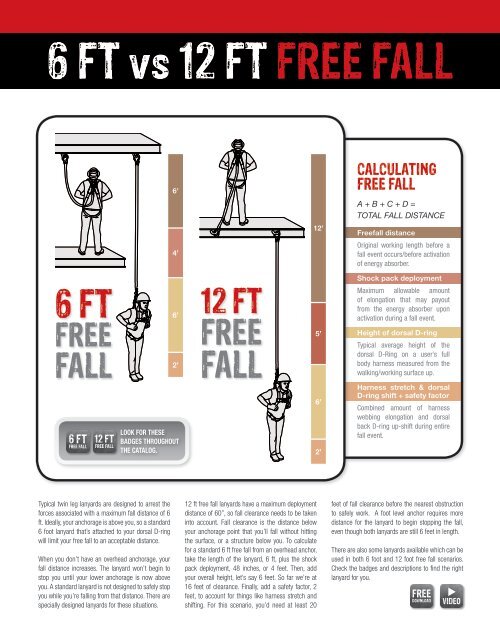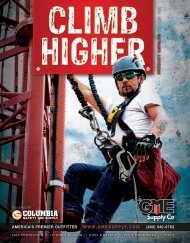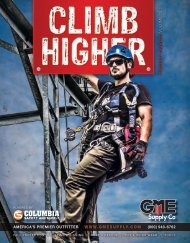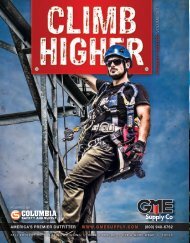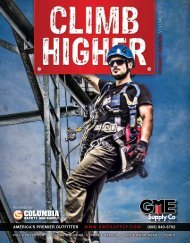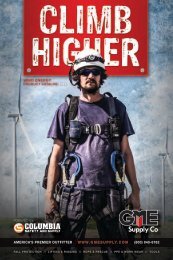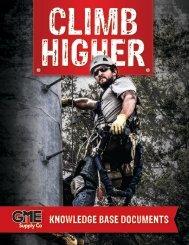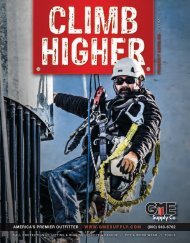GME Supply Product Catalog Version 16.3
GME Supply is North America's premier outfitter of fall protection, safety equipment, and gear for at-height workers, industry, and construction.
GME Supply is North America's premier outfitter of fall protection, safety equipment, and gear for at-height workers, industry, and construction.
You also want an ePaper? Increase the reach of your titles
YUMPU automatically turns print PDFs into web optimized ePapers that Google loves.
6 FT vs 12 FT FREE FALL<br />
6’<br />
CALCULATING<br />
FREE FALL<br />
A + B + C + D =<br />
TOTAL FALL DISTANCE<br />
12’<br />
Freefall distance<br />
Original working length before a<br />
fall event occurs/before activation<br />
of energy absorber.<br />
4’<br />
Shock pack deployment<br />
Maximum allowable amount<br />
of elongation that may payout<br />
from the energy absorber upon<br />
activation during a fall event.<br />
6 FT<br />
FREE<br />
FALL<br />
6’<br />
2’<br />
Look for these<br />
badges throughout<br />
the CATALOG.<br />
12 FT<br />
FREE<br />
FALL<br />
5’<br />
6’<br />
2’<br />
Height of dorsal D-ring<br />
Typical average height of the<br />
dorsal D-Ring on a user’s full<br />
body harness measured from the<br />
walking/working surface up.<br />
Harness stretch & dorsal<br />
D-ring shift + safety factor<br />
Combined amount of harness<br />
webbing elongation and dorsal<br />
back D-ring up-shift during entire<br />
fall event.<br />
Typical twin leg lanyards are designed to arrest the<br />
forces associated with a maximum fall distance of 6<br />
ft. Ideally, your anchorage is above you, so a standard<br />
6 foot lanyard that’s attached to your dorsal D-ring<br />
will limit your free fall to an acceptable distance.<br />
When you don’t have an overhead anchorage, your<br />
fall distance increases. The lanyard won’t begin to<br />
stop you until your lower anchorage is now above<br />
you. A standard lanyard is not designed to safely stop<br />
you while you’re falling from that distance. There are<br />
specially designed lanyards for these situations.<br />
12 ft free fall lanyards have a maximum deployment<br />
distance of 60”, so fall clearance needs to be taken<br />
into account. Fall clearance is the distance below<br />
your anchorage point that you’ll fall without hitting<br />
the surface, or a structure below you. To calculate<br />
for a standard 6 ft free fall from an overhead anchor,<br />
take the length of the lanyard, 6 ft, plus the shock<br />
pack deployment, 48 inches, or 4 feet. Then, add<br />
your overall height, let’s say 6 feet. So far we’re at<br />
16 feet of clearance. Finally, add a safety factor, 2<br />
feet, to account for things like harness stretch and<br />
shifting. For this scenario, you’d need at least 20<br />
feet of fall clearance before the nearest obstruction<br />
to safely work. A foot level anchor requires more<br />
distance for the lanyard to begin stopping the fall,<br />
even though both lanyards are still 6 feet in length.<br />
There are also some lanyards available which can be<br />
used in both 6 foot and 12 foot free fall scenarios.<br />
Check the badges and descriptions to find the right<br />
lanyard for you.<br />
(800) 940-6762<br />
35


